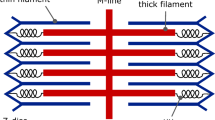Abstract
A model for the motor-unit action-potential train is developed, based on previously obtained empirical information. The auto and cross-correlation functions are calculated. The autocorrelation function is used to derive the mean rectified value, the variance and the root-mean-squared value of a motor-unit action-potential train. These parameters are solved by using two approximations for the motor-unit action-potential; a piece-wise approximation and a Dirac Delta function approximation. The Dirac Delta function approximation sufficiently simplifies the mathematics so that the model can be extended to myoelectric signals. The cross-correlation function contains information about the synchronization of motorunit action-potential trains that may be useful as an objective indicator of muscle fatigue.
Similar content being viewed by others
References
Basmajian,J.V., Cross,G.L.: Duration of motor unit potentials from fine-wire electrodes. Amer. J. Phys. Med. 50, 144–148 (1971)
Bernshtein,V.M.: Statisal parameters of the electric signal of a muscle model. Biophysics 12, 693–703 (1967a)
Bernshtein,V.M.: Modelling the electric signal of a group of muscle fibers. Biophysics 12, 1212–1218 (1967b)
Bigland,B., Lippold,O.C.J.: Motor unit activity in the voluntary contraction of human muscle. J. Physiol. 125, 322–335 (1954)
Brody,G., Balasubramanian,R., Scott,R.N.: A model for myoelectric signal generation. Med. Biol. Eng. 12, 29–41 (1974)
Buchthal,F., Gould,C., Rosenfalk,P.: Action potential parameters in normal human muscle and their dependence on physical variables. Acta Physiol. Scand. 32, 200–218 (1954)
Buchthal,F., gould,C., Rosenfalck,P.: Multielectrode study of the territory of a motor unit. Acta Physiol. Scand. 39, 83–104 (1957)
Clamann, P.H.: A quantitative analysis of the firing pattern of single motor units of a skeletal muscle of man, and their utilization in isometric contractions. Ph. D. Dissertation, John Hopkins 1967
Coggshall,J.C., Bekey,G.A.: A stochastic model of skeletal muscle based on motor unit properties. Math. Biosc. 7, 405–419 (1970)
De Luca, C.J.: Myoelectric analysis of isometric contractions of the human biceps brachii. M. Sc. Thesis Fredericton, N.B., Canada: University of New Brunswick 1968
De Luca,C.J., Forrest,W.J.: Some properties of motor unit action potential trains recorded during constant force isometric contractions in man. Kybernetik 12, 160–168 (1973)
Henneman,E., Somjen,G., Carpenter,D.O.: Functional significance of cell size in spinal motorneurons. J. Neurophysiol. 28, 560–580 (1965)
Knowlton,G.C., Bennett,R.C., McClure,R.: Electromyography of fatigue. Arch. Phys. Med. 32, 648–652 (1951)
Libkind,M.S.: II. Modelling of interference bioelectrical activity. Biofizika 13, 685–693 (1968)
Lindquist,C.: The motor unit potential in severely paretic muscles after acute anterior poliomyelitis. Acta Psychiat. Neurol. Scand. 34, Suppl. 131 (1959)
Lindström,L., Magnusson,R., Petersén,I.: Muscular fatigue and action potential conduction velocity changes studied with frequence analysis of EMG signals. Electromyography 10, 341–353 (1970)
Lindsley,D.B.: Electrical activity of human motor units during voluntary contraction. Amer. J. Physiol. 114, 90–99 (1935)
Lippold,O.C.J., Redfearn,J.W.T., Vučo,J.: The electromyography of fatigue. Ergonomics 3, 121–131 (1960)
Milner-Brown,H.S., Stein,R.B., Yemm,R.: The orderly recruitment of human motor units during voluntary isometric contractions. J. Physiol. 230, 359–370 (1973)
Morris,F.H.,Jr., Gasteiger,E.L.: Action potentials of single motor units in normal muscle. EEG Clin. Neurophysiol. 7, 115–126 (1955)
Person,R.S., Mishin,L.N.: Autor-und cross-correlation analysis of the electrical activity of muscles. Med. Electron Biol. Engng. 2, 155–159 (1964)
Petersén,I., Kugelberg,E.: Duration and form of action potential in the norman human muscle. J. Neurosurg. Psychiat. 12, 124–128 (1949)
Seyffarth,H.: The behaviour of motor units in voluntary contraction. Univ. of Oslo: Jacob Dybwad 1940
Shiavi,R.: Control and interaction between motor units in a human skeletal muscle during isometric contractions. Ph. D. Dissertation Drexel University 1972
Stålberg,E.: Propagation velocity in human muscle fibers in situ. Acta Physiol. Scand. 70, Suppl. 287 (1966)
Stern, M.M.: A model that relates low frequency EMG power to fluctuations in the number of active motor units: Application to local muscle fatigue. Ph. D. Dissertation, University of Michigan 1971
Author information
Authors and Affiliations
Rights and permissions
About this article
Cite this article
De Luca, C.J. A model for a motor unit train recorded during constant force isometric contractions. Biol. Cybernetics 19, 159–167 (1975). https://doi.org/10.1007/BF00337255
Received:
Issue Date:
DOI: https://doi.org/10.1007/BF00337255




